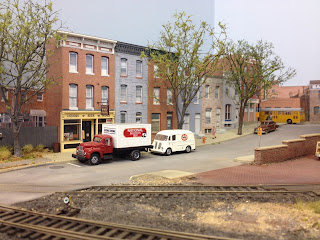 This weekend I poured two layers of two-part resin "water" on the diorama. This is always a stress filled event because if you get the resin mixture wrong, you risk ruining the model. I am happy to report that it worked as planned. The resin is curing and is ready for the final placement of the boats and last layer of acrylic gel to create waves.
This weekend I poured two layers of two-part resin "water" on the diorama. This is always a stress filled event because if you get the resin mixture wrong, you risk ruining the model. I am happy to report that it worked as planned. The resin is curing and is ready for the final placement of the boats and last layer of acrylic gel to create waves.While the resin was curing I made several details including a box car under construction, wheel sets along side the loco works, the coal wharf crane, and 4 tipper wagons for the coal yard. One wagon has a mule pulling it, while the others are in reserve.
The canal boat is typical of the type used on the C&O canal. They were 90 feet long and 14 feet wide. They could carry over 100 tons of coal. The coal crane on the wharf is based on photos of similar devices on the US Government coal wharf taken during the ACW.
Lots more detail to go, but the project is almost done.























